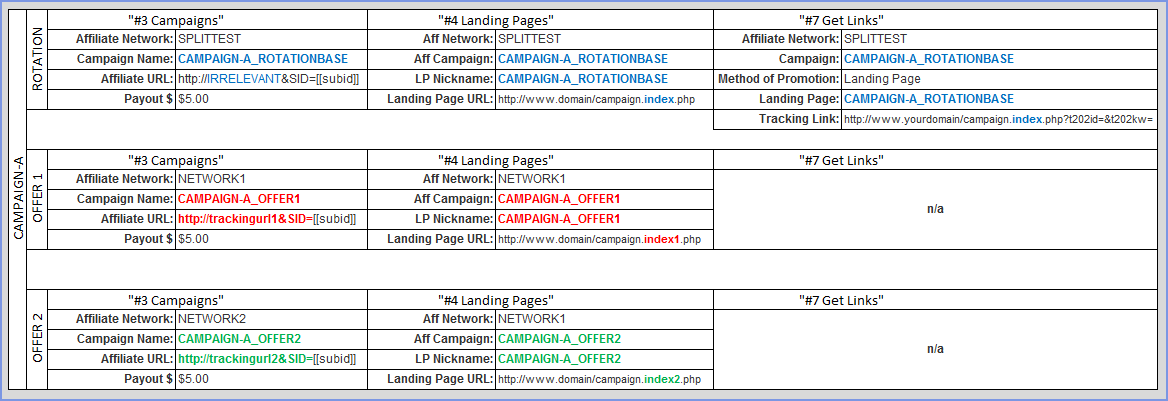When I first started out in this business I learned some things very quickly: without testing, nothing is ever certain. I made sure to split test every aspect of my campaigns to ensure that I was making the most out of my money. Still, the last thing I ever thought of was split testing traffic networks. I (like a lot of marketers) figured if two networks were providing the same offer with the same payout that the results of running with one over the other would be the same. However that’s rarely the case. There are always discrepancies between networks and the earning per click (EPC) they claim to provide. That’s why in a few posts back, I described how simple it is to rotate multiple offers and networks to split test each offer’s EPC utilizing a rotation script and some structural setup in Prosper202. But in this post, I wanted to reach further into how I optimize my campaigns on a network level and hopefully teach you how to do the same.
Trace, Organize and Terminate
Trace the Offer Path of Your Affiliate URL
If you can find out whether or not a network you’re using is going direct with an advertiser, there’s more room to scale and increase profits. You can ask your account manager if an offer you’re running is direct, but not all account managers are honest. I can’t tell you how many times I’ve been told by account managers that they were direct with an offer and that I was getting the best payout available aside from going direct myself, only to find out that they weren’t going direct at all.
That’s why I like to use a redirect tracer like the one at Wheregoes.com to figure out whether or not an offer provided by a network is direct. Tracing the offer path is important because when a network is direct, there is a direct line of communication between the network and advertiser. Direct communication between a network and an advertiser means a stronger relationship and greater trust which also means that you can request higher payouts more easily with more lenient terms.
Organize Your Campaigns in Prosper202
As I mentioned above, I already explained in a previous post how each campaign should be structured while using a rotation script to split test different networks but since the organization and structure of each campaign is crucial to the success of proper split testing, I wanted to quickly revisit how you can organize your campaigns in Prosper202 to properly track your creative campaigns when split testing.
Remember to keep things organized and simple. Below is a plain text layout of a generic campaign called “Campaign-A”.
Campaign-A consists of 3 parts: (1)”OFFER_ROTATION” campaign which is used as the rotation device, and two offer campaigns which rotate called (2)”OFFER_1″ and (3)”OFFER_2″. The chart below displays how each campaign should appear in the “Campaigns”, “Landing Page”, and “Get Links” tabs when setting up a Prosper202 campaign.

Once you’ve properly organized your Prosper202 campaigns, you can then incorporate the rotation script I previously provided to rotate 2 or more offers each creative campaign. If you’re not familiar with how to set up your rotation script, check out this easy-to-follow video I created for a previous post here:
This split testing helps you monitor which offer is more profitable. However, each offer’s EPC has a sort of ebb and flow. Because of that, there’s slightly more room for optimization.
Terminate the Loser(s)
The other tool I use on a regular basis to keep my campaigns running at maximum performance is our very own (and FREE!) P202 Offer Manager. If you’re not already using this to help you quickly and easily adjust your campaigns for a payout bump or change, you should definitely be using it to instantly change the offers you’re sending your traffic to when optimizing.
After I’ve determined which offer is working best for a campaign I’m running, I just start up the Offer Manager and change over the campaign to my desired offer. That being said, I’ve also found that on some days, some offers perform better than others, and to get the max profit out of each day, I also use the Offer Manager to switch around whatever’s working best that day, sort of juggling various offers throughout the lifetime of each campaign until there’s a clear difference in an offer’s performance.
These are the exact same methods and tools I use to make sure that I’m getting everything I can out of my campaigns. If you don’t have a system of your own, I urge you to try this out. The structure is admittedly a little anal, but I like to keep things split up and set up neatly so that if I need to make any quick changes in the name of optimization, I’m able to do so. If you have any questions about this post or have any optimization tips you use yourself, feel free to ask and share in the comment section below!
Leave a Reply